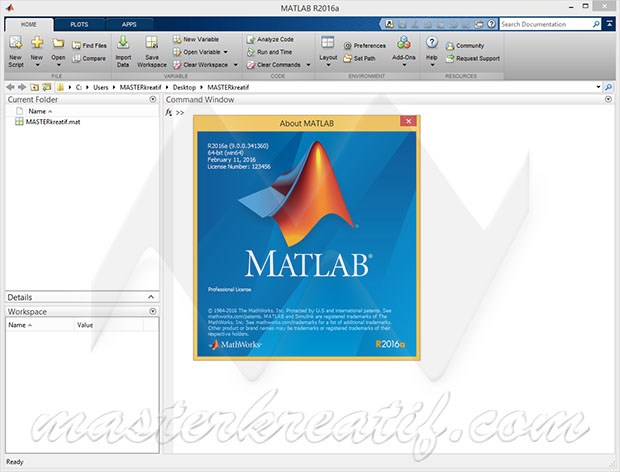Denosing Using Wavelets and Projections onto the L1-Ball
Jan 01, 2018 Dr.Web No viruses We are also looking: pes 2012 torrente crack serial, matlab r2010a license file crack torrent crack, nero 11 platinium. Matlab R2017a Crack with License File is the latest powerful and reliable multi-paradigm numerical computing environment. MATLAB Implementation of Overcurrent Relay Overcurrent relay is an important relay used to protect transmission and distribution feeders, transformer, bus coupler, etc. It can be used as main or backup protection relays.
L1-ball denoising software provides examples of denoising using projection onto the epigraph of L1-ball (PES-L1). Description of each file is given in the related mfile.Moreover, you can find complete explanation of the PES-L1 algorithm and the codes in the given pdf below. Please feel free to contact us if you had any question.
- L1-Ball Denoising Software : L1-Ball Denoising Software in MATLAB,
- Complete description of the codes is available in the following link: Denoising Using Wavelet and Projection onto the L1-Ball
Considering the following signal:
Fig. 1
This signal is corrupted with additive, i.i.d. Gaussian noise with zero mean (ξ [n]) as x[n] = v[n] + ξ[n], which v[n] is the original discrete-time signal and x[n] is the noisy version of v[n],which has standard deviation equal to 10% of the maximum amplitude of the original signal, which is shown below:

Fig. 2
PES-L1 using pyramidal structure:
PES-L1 ball denoising is applied according to the followoing block-diagram:
Fig. 3
The noisy signal is low-pass filtered with cut-off frequency/
And the resulting denoised signal, using this code PES_L1_Pyramid_Denoising, is as follows:
Fig. 4
PES-L1 using wavelet decomposition:
In denoising using PES-L1 with wavelet decomposition the It is possible to use the Fourier transform of the noisy signal to estimate the bandwidth of the signal. Once the bandwidthω0of the original signal is approximately determined it can be used to estimate the number of wavelet transform levels and the bandwidth of the low-band signalxL. In an-level wavelet decomposition the low-band signalxLapproximately comes from the
 ,
,Matlab Pes Tutorial

Fig. 5
Epigraph set based threshold selection is compared with wavelet denoising methods used in MATLAB [2, 3, 4, 5]. The 'piece-regular' signal shown in Fig. 1 is corrupted by a zero mean Gaussian noise with
The denoised 'piece-regular' signal with PES-L1 using wavelet decomposition is as follows:
Pesq Matlab Source Code
Bibliography
Matlab Presentation
[1] S. Mallat and W.-L. Hwang, “Singularity detection and processing with wavelets,” Information Theory, IEEE Transactions on, vol. 38, no. 2, pp. 617–643, Mar 1992.[2] D. Donoho, “De-noising by soft-thresholding,” Information Theory, IEEE Transactions on, vol. 41, no. 3, pp. 613–627, May 1995.
[3] M. Aminghafari, N. Cheze, and J.-M. Poggi, “Multivariate denoising using wavelets and principal component analysis,” Computational Statistics and Data Analysis, vol. 50, no. 9, pp. 2381 – 2398, 2006.
[4] P. J. Rousseeuw and K. V. Driessen, “A fast algorithm for the minimum covariance determinant estimator,” Technometrics, vol. 41, no. 3, pp. 212–223, 1999.
[5] S. Chang, B. Yu, and M. Vetterli, “Adaptive wavelet thresholding for image denoising and compression,” IEEE Transactions on Image Processing, vol. 9, no. 9, pp. 1532–1546, Sep 2000.
[6] D. L. Donoho and I. M. Johnstone, “Adapting to unknown smoothness via wavelet shrinkage,” Journal of the American Statistical Association, vol. 90, no. 432, pp. 1200–1224, 1995. [Online]. Available: http://amstat.tandfonline.com/doi/abs/10.1080/01621459.1995.10476626
[7] G. Chierchia, N. Pustelnik, J.-C. Pesquet, and B. Pesquet-Popescu, “An epigraphical convex optimization approach for multicomponent image restoration using non-local structure tensor,” in IEEE ICASSP, 2013, 2013, pp. 1359–1363.
[8] A. E. Cetin, A. Bozkurt, O. Gunay, Y. H. Habiboglu, K. Kose, I. Onaran, R. A. Sevimli, and M. Tofighi, “Projections onto convex sets (POCS) based optimization by lifting,” IEEE GlobalSIP, Austin, Texas, USA, 2013.
[9] K. Kose, V. Cevher, and A. Cetin, “Filtered variation method for denoising and sparse signal processing,” in 2012 IEEE International Conference on Acoustics, Speech and Signal Processing (ICASSP), March 2012, pp. 3329–3332.
[10] G. Chierchia, N. Pustelnik, J.-C. Pesquet, and B. Pesquet-Popescu, “Epigraphical projection and proximal tools for solving constrained convex optimization problems: Part i,” Arxiv, CoRR, vol. abs/1210.5844, 2012.
[11] J. Duchi, S. Shalev-Shwartz, Y. Singer, and T. Chandra, “Efficient projections onto the l1-ball for learning in high dimensions,” in Proceedings of the 25th International Conference on Machine Learning, ser. ICML ’08. New York, NY, USA: ACM, 2008, pp. 272–279.
[12] R. Baraniuk, “Compressive sensing [lecture notes],” IEEE Signal Processing Magazine, vol. 24, no. 4, pp. 118–121, 2007.
[13] J. Fowler, “The redundant discrete wavelet transform and additive noise,” Signal Processing Letters, IEEE, vol. 12, no. 9, pp. 629–632, Sept 2005.